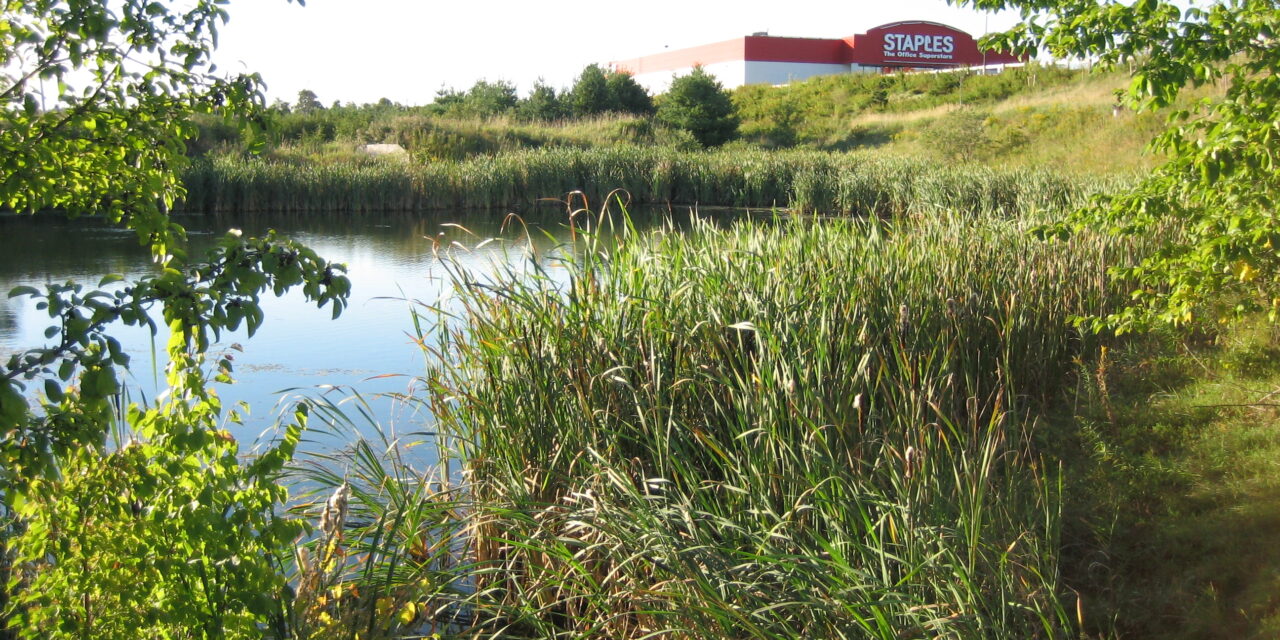The River Owns Itself
by Lowry Pei
“Those who are good at controlling water give it the best opportunity to flow away.”
— Chia Jang, Taoist engineer of the Han period
[With this posting by Lowry Pei, we are initiating what we hope will be an ongoing series of posts on waterways. We intend the category to be capacious, to designate the streams and rivers that enlace the landscapes where we live, marking boundaries, empowering economies, encouraging human flows, causing floods, and delighting fishermen (sic), swimmers, sailors, poets, and the lovers who recline along their banks. Also the seas that carry goods and people around the world. Even the clouds that are water’s way of moving from here to there, over oceans and continents, distributing bounty or unleashing devastating torrents of rain. We mean as well the waterways that have become hotspots in the resource wars that will be breaking out more and more frequently as climate change redistributes water, population growth increases demand, and pollution poisons the precious aquifers beneath our feet. Even pipes are waterways, of course, and there’s much to be said about Dakota pipelines and, more recently, the frozen pipes of Texas.
So please keep an eye out for future postings and send us proposals or postings of you own. We love the tone of Lowry’s piece, and welcome both explicitly political interventions and interventions in which the political wells up, if it does at all, through renderings of and reflections on more personal experience.
–The Editors]
In August of 2007 an opinion piece appeared in the San Francisco Chronicle calling for action to save the Salton Sea, a large – but shrinking – salty lake in the Imperial Valley, near the border with Mexico. It has been slowly drying up and becoming more saline for years. It’s already one-third more salty than the ocean, it’s getting less inflow of water than it used to, and as the article pointed out, if something isn’t done pretty soon, it will pass a tipping point. The process will speed up drastically, and this body of water will disappear, depriving over 400 species of birds of a valuable habitat and exposing dried lakebed off which clouds of toxic dust will blow, polluting the air that already causes three times more childhood asthma in Imperial County than in any other county in California. That’s exactly what happened to the Aral Sea in Central Asia, formerly the fourth-largest freshwater lake in the world, which has now died and become an environmental disaster, thanks to incredibly ill-advised irrigation projects.
So act now! Save the Salton Sea! The writer supported a proposed plan for how to do this, with an estimated cost of $8.9 billion.
The article didn’t mention where the Salton Sea came from in the first place: we humans put it there. By accident. In 1905, during the frantic development of the Imperial Valley as irrigated farmland, an engineer named Rockwood decided to divert the flow of the Colorado River so that workers could dig out silted-up irrigation canals. They made an opening in the riverbank, but before they could finish constructing the works that were going to control the outflow, there was a series of floods and the river, unstoppable, raged through the newly cut opening. It roared into what was then called the Salton Sink, a dried-up below-sea-level lake bed in the delta of the Colorado River, and kept pouring in there for two years; it turned the Sink into the Salton Sea before they could get it under control. So when the article in the Chronicle talked about “restoring” the Salton Sea, I wasn’t sold on that verb. Basically this so-called “restoration,” a word which suggests preserving something given by nature, would perpetuate a situation that we inadvertently created 100 years ago.
Online I found the 53-page official document about the 8.9 billion dollar plan. The idea – nothing if not ambitious – was to divide the Salton Sea with a 52-mile-long rock barrier, then maintain part of it at about the salinity of the ocean and other areas as a “saline habitat complex” that would be, in some parts, something like six times as salty as the ocean. All this would happen around the perimeter, turning the Salton Sea into a giant horseshoe, and leaving the middle to become dried salt flats and “brine sinks.” The proposal included various measures to try to control air pollution from blowing dust, such as “water efficient vegetation” which would need its own irrigation system, budgeted at $891 million in capital costs and $99 million a year in operations and maintenance thereafter. The whole plan exemplified one of the fundamental assumptions underlying the development of the West, and especially the management of its scarce water: every problem can be fixed by technical expertise.
The Salton Sink has been intermittently filled by the Colorado River, and then has dried up again in the baking sun, over and over for longer than we can imagine, as the river has formed its delta. In this particular case, along came human beings, inserted themselves into the ecosystem, and helped it flip from one side of the cycle to the other. When Rockwood cut into the riverbank in 1905, he only did what the river itself would have done sooner or later. Given that the river has been building its delta for about three million years, changing course constantly in the process, the fact that Rockwood slightly hastened this particular phase shift is insignificant. From that point of view, this problem isn’t even a problem. The ecosystem has been through all this before, uncounted times. There was a lake in the same basin far bigger than the Salton Sea, known as Lake Cahuilla, as of about the year 1200, but when the Spaniards came in 1600, there was no lake there, just Indian legends that said one had existed. It’s a little different this time because of the extra-high salinity of irrigation runoff and the addition of agricultural chemicals, but the fact that the Salton Sea is drying up is business as usual. The 400 species of birds who use it as their habitat or a stopover on their flyway were surviving somehow before 1905, when there was no water in the Sink, and they have been through this cyclic change, as a species, for so long it probably means that evolution long ago took into account the constant change in their habitat.
This thing called “restoring the Salton Sea,” if it ever were to happen, would be an attempt to arrest the cycle in its present state, as if that were the correct one, and keep it from switching yet again to its alternate. To stop the clock. But in this game there is no permanence and there are no time outs. Perhaps the true problem here is our relationship with time: our horizon is too nearby. We have too much stake in how things are now. Though we live in a world of process and flux which has no end point, though we’re in the midst of a ceaseless evolution, this is exactly what we don’t seem able to accept.
Instead we seem to believe, deep down, that the sorts of dramatic changes that happened in the earth’s past should stop occurring now that we’ve arrived on the scene. The Salton Sea “restoration” project says we believe we live in a world beyond nature, after nature. We have become used to the role of engineering a vast landscape to get water where it isn’t, and in the process have all but accepted that we must create and maintain a simulated nature. I think many of us also feel that something’s wrong with this picture, but we don’t know how to get outside the frame.
*
Under English common law, no one could own the water in a river. The river belonged either to everyone or to no one. In the 19th century in the American West, a new form of water law emerged, called the doctrine of prior appropriation: whoever started digging his irrigation ditch first owned the water. Finders keepers. What you could not do was prevent appropriation of the water; it was there to be used. From the time the Mormons dug their first irrigation ditch in 1847, maximizing the bounty of the Western earth has been portrayed as God’s plan carried out through settlers of Northern European descent – obligatory, pious, and profitable.
For much of our history, Americans have dealt with this continent on the basis of three unexamined assumptions that turn out to be mistaken. The first two of them are supported by overconfidence in the completeness of our knowledge:
1. Humans can and should absolutely dominate nature.
2. There’s a technical fix for every problem.
3. The ultimate goal is ceaseless and unlimited economic growth.
In the West, these most obviously took the form of colossal dams transforming flowing rivers into static reservoirs for the purpose of irrigation projects like that in California’s Central Valley, and turbines generating electric power at bargain prices. The Bureau of Reclamation and the Corps of Engineers have not only reshaped whole watersheds but joined forces with industrial agriculture and massive real-estate development to create a self-reinforcing system of economic domination. Though the West has always been the home of the most libertarian strain of American politics, it is ironically the most thoroughly dependent on federal government projects that supply water at heavily subsidized rates, often to those who are already getting rich. More ironically, some of this cheap water is used to irrigate price-supported crops.
Subsidy or no, such practices don’t come without a price. Land that is intensively irrigated inexorably becomes more and more saline, to the point where it is no longer usable for agriculture. This is no secret – it has been documented in many parts of the world, and may have caused the collapse of ancient desert civilizations. An elaborate system of drains has been constructed underneath much of the Central Valley in order to draw down the water table which has been raised by irrigation, so that the salty irrigation runoff won’t come in contact with the roots of plants and kill them. Which is a prime example of the rule that every technical fix – in this case, irrigation – will require another technical fix. But then, where do you put that salty water? Some of it goes to the Salton Sea.
*
The history of water in the West connects directly to the agrarian American dream: the family making a decent living on its own land, a respectable, self-reliant life close to the rhythms of nature. The rationale for the Bureau of Reclamation’s irrigation projects in the West was the government-subsidized creation of 160-acre farms, sufficient to support a family, where supposedly the wretched slum dwellers of the East would be able to find a new life. Starting with the National Reclamation Act of 1902, this vision successfully sold gargantuan water projects for decades, whether or not the upshot was an irrigated utopia for the family farmer. It mostly wasn’t; those projects principally benefitted major landowners like Standard Oil, Getty, Shell, Prudential, and the Southern Pacific Railroad.
We 21st century Americans still like to imagine our relationship to nature in the form of a self-sustaining family farm. John Stilgoe, in Outside Lies Magic, ingeniously writes that the typical suburban yard is
. . . a miniature farm, a sort of living mausoleum of 1840’s-style farming. A fruit tree or two recalls the orchard. The patch of vegetable garden reminds everyone of great fields once planted to tomatoes, cabbage, peppers, potatoes. The backyard, usually more or less fenced, is vestigial pasture, roamed by the substitute livestock, a dog and a cat. And the front yard . . . recalls the meadow, the source of hay.
When my wife Vaughn and I started keeping hens in our backyard in Cambridge, Massachusetts, we were worried that the neighbors would object to them; in fact, the hens seemed to delight just about everyone, except for the few who were pecked by chickens as children. Rural nostalgia still ruled, even when our second or third set of hens started waking me up at 5:30 a.m. by cackling their eagerness to get out of their coop.
The agrarian version of relationship with nature is a very different thing from the Sierra Club vision of wilderness, nature as the Other with a capital O which we must leave untouched. The two are inherently contradictory. Wilderness is an icon of purity that exists elsewhere, where we are not, while the agrarian notion is that we can work with nature hand in glove. A farm isn’t exactly nature but it definitely is a relationship to it: as I imagine it, on the ideal farm that relationship would be one of collaboration.
The nature I mean when I use the word is not wilderness, and we are not excluded from it; it is a hybrid and impure nature that includes us and our works. I don’t believe there has to be a tragic binary division between nature and human beings; rather I believe that we create the tragic binary by seeking to dominate nature totally. The origin of the Salton Sea is a story of an effort to dominate that transformed inadvertently into collaboration. Rockwood and his workmen became, in effect, forces of nature, like the river; the engineer and the river didn’t mean to work together, but they did. Chia Jang, the Taoist engineer quoted in the epigraph, would have congratulated Rockwood because he gave water “the best opportunity to flow away.” It was his failure to control the river’s flow that produced a result so desirable to birds, fish, and human beings that no one wants to see it dry up. Success in irrigating the Central Valley, on the other hand, is gradually becoming a Pyrrhic victory through salinization of the soil.
Even though the nature I use as my point of reference is not necessarily any farther away than my backyard, it can still have its own integrity. Water is what it is, not what we make it. We can neither create more water nor destroy the H2O that exists. The integrity of the Salton Sea is that it will dry up, and in some hundreds or thousands of years, the Colorado River will re-create it in a different form. This, rather than some distant wilderness, is the sense in which nature is an Other; sooner or later, there comes a time when we don’t have the choice of ignoring its autonomy. Nature as Other and nature as our collaborator ultimately converge: we can only collaborate with nature by always remembering to respect its integrity.
“Restoring” the Salton Sea would be an act of simulation rather than collaboration; it would put us absolutely at the controls. But when we engineer too much of the world, we suck out too much of its otherness and then we have nothing to be in a relationship with, nothing to respect and understand, because we’re facing our own creation. We find ourselves alone in a hall of mirrors. Either we’re so narcissistic that we like this, or we start suffering from loneliness, or worse, find ourselves standing on the brink of a void.
There are two different kinds of danger in the attempt to dominate nature totally, and we are facing them both. One is that when we succeed too well in the project of domination, our spirit is in danger of desiccation. The other danger arises in the unintended, unanticipated, or just plain wilfully ignored consequences of not knowing what we’re doing when we mess around with nature – danger to our survival. We’ve engineered our way out onto a limb that’s about to break under the weight of our numbers, and made ourselves spiritually poorer in the process.
*
At the end of one August, on the way back from Prince Edward Island, where we go every summer, Vaughn and I stopped at a Hampton Inn in the midst of the Bangor Mall. It sits behind a Toys ‘R’ Us, next to a 99 Restaurant & Pub. Near it are Wendy’s, Starbucks, Borders, Best Buy; in the middle distance is Macy’s, a windowless beige fortress on a slight rise. These are only the immediately visible landmarks. The giants of American retail have set up shop here in a trackless maze of parking lots.
In the evening, I went out for a walk which I fully expected would be at best an ironic gesture. I told Vaughn I was going to go look at nature, in this bucolic environment. It was on the verge of getting dark. I walked down the side of the Hampton Inn’s driveway and saw to my surprise that there was a big open space, a declivity of some kind, not paved, maybe a hundred yards across, between that road and Borders. Why hadn’t I noticed that driving in? It was a definite valley, filled with dense vegetation and some trees. I walked to the end of the driveway, crossed the parking lot of Starbucks, got to more of a main road which even had a sidewalk. I turned downhill and where the road crossed over the unpaved land, I heard the sound of water running down below. There was a creek flowing into the area, rippling slightly. This was getting interesting. On the other side, I left the sidewalk and climbed up a slope below Borders, walked along its blank side wall looking down, as best I could in the dark, at the land below me. The creek, surrounded by reeds, widened out into pools. There was what appeared to be a berm, an earthen dam, something constructed, though completely covered in grasses and bushes. Near the corner of the building, on the side where presumably almost no one went, there was a picnic table. An amenity for employees on break? A woman was sitting on the low fence of the parking lot which lay beyond Borders, drinking a takeout coffee. I realized there was a pond down below, open water under the sky. “There’s an actual landscape back here!” I said to her, unable to keep it to myself.
“An otter lives down there,” she said. She told me that all of the surrounding land used to be cow pastures and when they built the mall, they left this part for drainage. In the spring, when the snow melts, it floods. I kept going along the edge of the parking lot and the blank side of Staples; the first pond was succeeded by a second. There were some trees scattered through the area, but mostly it was tall grasses and reeds. I figured periodic flooding kept trees from growing in. This was, in fact, nature, framed by unlimited economic growth.
In the early morning Vaughn and I tried to photograph the scene. We parked in the Borders parking lot, and Vaughn got out her large-format camera and her tripod. It was quiet. She set to work and I wandered off with a digital point ‘n’ shoot in my pocket. I know not to get in the way when she’s photographing.
I stepped over the low fence that made a visual boundary, but no real barrier, between the parking lot and the plant life. I headed down the slope into the tall grass, toward the water, waded through some high weeds, worked my way through small trees and vines and cattails. Burrs stuck to my clothes. I got closer to a spot where the water narrowed and was hidden by saplings.
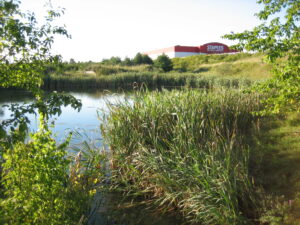
With a flurry of wings three cormorants burst out of the reeds and came to a stop in the middle of the pond, where they floated, looking back at me warily.
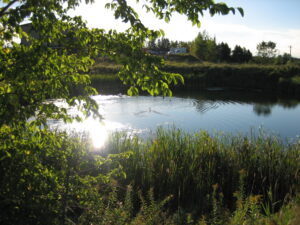
I had inadvertently flushed them out of a peaceful resting spot, but after a moment they seemed to forget about me. I started photographing the view looking up from the edge of the stream. The works of man, in the form of Staples and Borders, loomed over cattails and bushes and saplings. The stores were definitely elsewhere now, from my point of view. The onramp of I-95 defined one end of the valley, but from below, the passing cars and trucks could not be seen. Not more than fifty yards from the fence, probably less, I was in a completely different space. Certainly a person up there on the pavement could not feel, even from that short distance away, what it was like to be down at the water surrounded by plants. I had no sense that this was anything but nature, despite what was around it. I kept on following the bank, pushing aside the plant life.
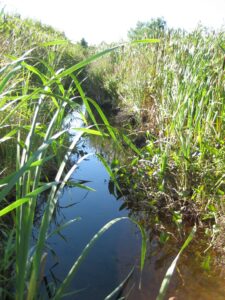
There was no evidence of a path; it must be, I thought, that no one comes down to the water. Why?
Another cormorant flew in and landed on the narrower neck of water below Wendy’s.
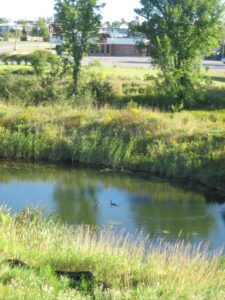
A woman who worked there swept the edge of the parking lot with a broom, methodically, in no hurry. It was an oddly domestic tableau, as if this were her side yard, above the brook, and she were the homeowner devoted to her home place.
I was beginning to see Bangor Mall as land rather than pavement, made up of gradually rolling rises and lower spots between them. Macy’s was perched on high ground, Wendy’s was a little lower but still well above the stream. I could almost imagine the mall back to its former life as a cow pasture.
While I stood by the side of the pond, three small birds flew up and alighted in a tall shrub near me, ten feet away at most. At first I thought they were goldfinches, but because they didn’t go away I got a good look at them and saw that they were smaller and plumper, not as yellow as goldfinches, with longer narrower beaks. They knew I was there – they visibly looked at me – but I held still and they didn’t mind me. I wanted to take their picture, but they were much too tiny to show up in a photo and I knew I’d probably scare them away by pointing the camera. It seemed to me that the place was almost a wildlife refuge. Odd but maybe true. Refuge from the encroachment of people. But these birds, whatever they were called, were letting me share the space with them and this seemed like a message that if we would just learn to show a little restraint instead of trying to control everything, the natural world would still be ready to coexist with us. We are, whether we know it or not, still part of the ecosystem.
Slowly the sun got higher, a few cars showed up in the lot. The café at Borders opened and people started coming to drink coffee there. They didn’t walk over to the edge and enjoy the view; they parked their cars and went right inside.
In the parking lot, an employee hooked up a hose to a spigot on the wall of Borders and started watering the spindly saplings growing on the islands that divided up the parking lot. Her car was there beside her, with its door open and the radio on, talking to her. As she worked her way slowly down the row, she moved her car from time to time so she could continue to hear its radio.
A pleasant job, certainly. But I wondered if it would occur to her, when she finished work, that she could step over the low fence and go down to the water, and spend part of her day in the company of that stream which still belonged, despite everything, to itself.
Notes
Epigraph: quoted in Donald Worster, Rivers of Empire: Water, Aridity, and the Growth of the American West. New York: Oxford UP, 1985. p. 46.
Opinion piece: Michael Cohen, “Salton Sea – A time for action,” San Francisco Chronicle, August 19, 2007.
Aral Sea: Marq de Villiers, Water: The Fate of Our Most Precious Resource. Houghton Mifflin, 2001, pp. 105-116.
Origin of the Salton Sea: see Worster, pp. 195-197; Marc Reisner, Cadillac Desert: The American West and its Disappearing Water. New York: Penguin, 1993. pp. 122-123.
Official proposal for restoration of the Salton Sea: http://www.saltonsea.water.ca.gov/docs/Pref_Alt_and_Funding_Plan_Report_May_2007.pdf
In 2008 the Legislature approved the following expenditure (Chapter 374, Statutes of 2008): Salton Sea Restoration. The budget provides about $14 million (bond funds) for planning, monitoring, and various early actions relating to the restoration of the Salton Sea. http://www.lao.ca.gov/2008/spend_plan/spending_plan_08-09.aspx
As of February 2021, the state is funding efforts to mitigate the emission of toxic dust from the exposed lake bed. The vastly more ambitious restoration project remains on hold.
Delta of the Colorado and Lake Cahuilla: Eugene Singer, “Geology of the Imperial Valley.” http://www.sci.sdsu.edu/salton/AncientLakeCahuilla.html
“The river, it was then believed . . . belonged to itself”; doctrine of prior appropriation: Worster, p. 88.
“the riparian owner . . . could not . . . insist that the stream flow undisturbed by his porch, affording an amenity to enjoy, nor could he protect it as the handiwork of God. Both would have been indeed unreasonable and wasteful.” Worster, p. 108.
agricultural runoff to the Salton Sea: Elizabeth G. Hill (Legislative Analyst’s Office), “Restoring the Salton Sea.” pp. 4-5. http://www.saltonsea.water.ca.gov/docs/Restoring_SS.pdf
The suburban yard like a miniature 1840’s farm: John Stilgoe, Outside Lies Magic. New York: Walker & Co., 1998. pp. 126-127.

